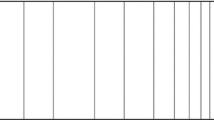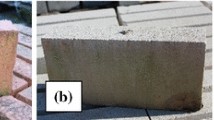Abstract
Heat and moisture transfer models are increasingly used in building thermal and energy simulation tools. These phenomenological transfer models are based on experimentally evaluated input data. Therefore, to ensure a better prediction of the hygrothermal behavior of the building envelope, a correct and reliable experimental evaluation of these parameters is required. Indeed, these input data are the thermal and hygric properties of the materials constituting the wall. However, the hygrothermal properties available in the databases are far from complete, particularly regarding the evolution of these properties with changes in the water content and temperature of the material. In this paper, an experimental characterization campaign of the main transfer and storage hygrothermal properties is conducted, with particular interest in the variation of these properties as a function of the temperature and the water content of the material. In this work, different materials are analyzed: cinderblock, plaster, chipboard and red brick. This study includes analysis of the thermal conductivity, the specific heat capacity, the water vapor permeability, and the moisture storage capacity. The obtained results confirmed that the water content and the temperature of the material have considerable effects on the values of its hygric and thermophysical properties. Indeed, the thermal conductivity and the specific heat capacity of a hygroscopic material as plaster can reach an increase of 2 times between dry and saturated states. Concerning water vapor permeability, a relative gap of 30% is observed between the values obtained at 20 °C and 30 °C. Therefore, enriching existing databases with this type of information is essential to ensure a reliable prediction of the hygrothermal behavior of the whole building.









Similar content being viewed by others
References
Liu JY (1991) Solutions of Luikov equations of heat and mass transfer in capillary-porous bodies. Int J Heat Mass Transf 34(7):747–1754
Belarbi R, Qin M, Ait mokhtar A, Nilsson LO (2008) Experimental and theoretical investigation of non-isothermal transfer in hygroscopic building materials. Build Environ 43:2154–2162
Qin M, Belarbi R, Aït-Mokhtar A, Nilsson LO (2009) Coupled heat and moisture transfer in multi-layer building materials. Constr Build Mater 23(2):967–975
Janssen H, Blocken B, Carmeliet J (2007) Conservative modelling of the moisture and heat transfer in building components under atmospheric excitation. Heat Mass Transf 50(5):1128–1140
Pedersen CR (1992) Prediction of moisture transfer in building constructions. Build Environ 27(3):387–397
Philip J, De Vries D (1957) Moisture movement in porous material under temperature gradients. Trans Am Geophys Union 2(38):222–232
Ferroukhi MY, Abahri K, Belarbi R, Limam K (2015) Experimental validation of coupled heat, air and moisture transfer modeling in multilayer building components. Heat Mass Transf 52(10):1–15
Luikov AV (1966) Heat and mass transfer in capillary porous bodies. Pergamon, London
Dos Santos GH, Mendes N (2009) Heat, air and moisture transfer through hollow porous blocks. Int J Heat Mass Transf 52(9):2390–2398
Fabbri A, McGregor F (2017) Impact of the determination of the sorption-desorption curves on the prediction of the hemp concrete hygrothermal behaviour. Constr Build Mater 157:108–116
Ferroukhi MY, Belarbi R, Limam K (2014) Effect of Hygrothermal transfer on multilayer walls behavior, Assessment of Condensation Risk. Adv Mater Res 1051:647–655
Pavlík Z, Žumár J, Medveď I, Černý R (2012) Water vapor adsorption in porous building materials: experimental measurement and theoretical analysis. Transp Porous Media 91:939–954
Ochs F, Heidemann W, Müller-Steinhagen H (2008) Effective thermal conductivity of moistened insulation materials as a function of temperature. Int J Heat Mass Transf 51(3):539–552
Karamanos A, Hadiarakou S, Papadopoulos AM (2008) The impact of temperature and moisture on the thermal performance of stone wool. Energy Buil 40(8):1402–1411
Jerman M, Černý R (2012) Effect of moisture content on heat and moisture transport and storage properties of thermal insulation materials. Energy Build 53:39–46
Bennai F, Issaadi N, Abahri K, Belarbi R, tahakourt A (2018) Experimental characterization of thermal and hygric properties of hemp concrete with considiration of the material age evolution. Heat Mass Transf 54(4):1189–1197
Mar J, Litovsky E, Kleiman J (2008) Modeling and database development of conductive and apparent thermal conductivity of moist insulation materials. J Build Phys 32:9–31
Walker R, Pavía S (2018) Thermal and moisture monitoring of an internally insulated historic brick wall. Build Environ 133:178–186
Pavlík Z, Fiala L, Vejmelková E, Černý R (2012) Application of effective media theory for determination of thermal properties of hollow bricks as a function of moisture content. Int J Thermophys 34(5):894–908
Jerman M, Keppert M, Výborný J, Černý R (2011) Moisture and heat transport and storage characteristics of two commercial autoclaved aerated concretes. Cem Wapno Beton 16(78):18–29
Kunchariyakun K, Asavapisit S, Sombatsompop K (2015) Properties of autoclaved aerated concrete incorporating rice husk ash as partial replacement for fine aggregate. Cem Concr Compos 55:11–16
Pehlivanlı ZO, Uzun İ, Yücel ZP, Demir İ (2016) The effect of different fiber reinforcement on the thermal and mechanical properties of autoclaved aerated concrete. Constr Build Mater 112:325–330
Gourlay E, Glé P, Marceau S, Foy C, Moscardelli S (2017) Effect of water content on the acoustical and thermal properties of hemp concretes. Constr Build Mater 139:513–523
Latif E, Lawrence RMH, Shea AD, Walker P (2018) An experimental investigation into the comparative hygrothermal performance of wall panels incorporating wood fibre, mineral wool and hemp-lime. Energy Build 165:76–91
Zhao J, Plagge R (2015) Characterization of hygrothermal properties of sandstones impact of anisotropy on their thermal and moisture behaviors. Energy Build 107:479–494
Vejmelková et al (2015) Engineering properties of concrete containing natural zeolite as supplementary cementitious material: strength, toughness, durability, and hygrothermal performance. Cem Concr Compos 55:259–267
Issaadi N, Nouviaire A, Belarbi R, Aït-Mokhtar A (2015) Moisture characterization of cementitious material properties: assessment of water vapor sorption isotherm and permeability variation with ages. Constr Build Mater 83:237–247
Qin M (2008) Etude des phénomènes de transfert hygrothermiques dans les parois des bâtiments. Université de La Rochelle, La Rochelle
Abahri K (2012) Modeling of coupled heat, air and moisture transfer in porous building materials. La Rochelle university, La Rochelle
Kus H, Nygren K, Norberg P (2004) In-use performance assessment of rendered autoclaved aerated concrete walls by long-term moisture monitoring. Build Environ 39(6):677–687
Kus H, Nygren K (2010) Microenvironmental characterization of rendered autoclaved aerated concrete. J Build Res Inf 30:25–34
Černý R, Rovnaníková P (2002) Transport processes in concrete. Spon Press, London
Comsol Multiphysics (2012) User’s guide, Comsol Multiphysics User’s Guide
Solar Energy Laboratory (2010) TRANSSOLAR Energietechnik GmbH, CSTB – Centre Scientifique et technique du Bâtiment, et TESS – thermal energy systems specialists, TRNSYS 17 a TRaNsient SYstem simulation Program
Ferroukhi MY, Djedjig R, Limam K, et Belarbi R (2016) Hygrothermal behavior modeling of the hygroscopic envelopes of buildings : a dynamic co-simulation approach. Build Simul 9(5):501–512
Woloszyn M, Rode C (2007) IEA annex 41, MOIST-ENG subtask 1 – modelling principles and common exercises, Final Report
Daian J (1986) Processus de condensation et de transfert d’eau dans un matériau meso et macroporeux : étude expérimentale du mortier de ciment. Université Scientifique et Médicale de Grenoble, Grenoble
NFEN12664 (2001) Performance thermique des matériaux et produits pour le bâétiment - Détermination de la résistance thermique par la méthode de la plaque chaude gardée et la méthode flumétrique - Produits de haute et moyenne résistance thermique
NFEN12667 (2001) Performance thermique des matériaux et produits pour le bâétiment - Détermination de la résistance thermique par la méthode de la plaque chaude gardée et la méthode flumétrique - Produits de haute et moyenne résistance thermique
Klute A (1986) Methods of soil analysis, Part 1. Physical and Mineralogical Methods. Agronomy Monograph 9 (2nd edition)
Burke W, Gabriels D, Bouma J (1986) Soil structure assessment. A.A. Balkema, Rotterdam/Boston
European Standard ISO 12572 (1997) Determination of water vapor transmission properties (ISO/DIS 12572 : 1997) PrEN ISO 12572
Qin M, Belarbi R, Ait Mokhtar K, Nilsson LO (2008) Nonisothermal moisture transport in hygroscopic building materials: modeling for the determination of moisture transport coefficients. Transp Porous Med 72:255–271
Roels S (2002) Modelling unsaturated moisture transport in autoclaved aerated concrete: a microstructural approach. Proceedings of the 6th Nordic Symposium of Building Physics, Norwegian University of Science and Technology, Trondheim, Norway
Poyet S (2009) Experimental investigation of the effect of temperature on the first desorption isotherm of concrete. Cem Concr Res 39(11):1052–1059
Aït Oumeziane Y, Moissette S, Bart M, Lanos C (2016) Influence of temperature on sorption process in hemp concrete. Constr Build Mater 106:600–607
Author information
Authors and Affiliations
Corresponding author
Additional information
Publisher’s Note
Springer Nature remains neutral with regard to jurisdictional claims in published maps and institutional affiliations.
Rights and permissions
About this article
Cite this article
Ferroukhi, M., Belarbi, R., Limam, K. et al. Assessment of the effects of temperature and moisture content on the hygrothermal transport and storage properties of porous building materials. Heat Mass Transfer 55, 1607–1617 (2019). https://doi.org/10.1007/s00231-018-02550-5
Received:
Accepted:
Published:
Issue Date:
DOI: https://doi.org/10.1007/s00231-018-02550-5




